
Overland Tech and Travel
Advice from the world's
most experienced overlanders
tests, reviews, opinion, and more
The physics of tires and lifts
 The JATAC with Four Wheel Camper mounted; LT235/85 R16 BFG All-Terrain tires, Boss air bags on stock rear springs, Icon shocks at all four corners.
The JATAC with Four Wheel Camper mounted; LT235/85 R16 BFG All-Terrain tires, Boss air bags on stock rear springs, Icon shocks at all four corners.
At the Overland Expo this May, Roseann gave a walkaround of the JATAC to a crowd of about 40 attendees, and throughout the weekend we were frequently approached by individuals and couples who’d seen it displayed or had read about it here, and who had various questions. Most were of the general general how-do-you-like-the-combination sort; many got into specifics of our modifications. But two questions about what we hadn’t done cropped up with interesting frequency:
- “Why didn’t you install a suspension lift?”
- “Why didn’t you install larger tires?”
The short answer to both questions is, “Physics.” The long answer follows.
Our goal in mating a Toyota Tacoma with a Four Wheel Camper was to strike a balance between reliability, durability, capability, comfort, and convenience. The camper provides comfort and convenience; it’s up to the truck to contribute reliability, durability, and capability. Part of the balance is realizing that roughly 1,000 pounds of comfort and convenience has potentially significant effects on the other three.
Reliability of the Tacoma should be a given. The Identifix rating for the current generation Tacoma shows five stars for every year since 2006. Our 2000 Tacoma was the single most reliable vehicle I have ever owned: In 160,000 miles we did nothing to it except scheduled maintenance. Not one repair. Even my faithful 1973 FJ40 couldn’t match that record at that mileage (burned exhaust valve at 150,000). It’s still too early to pass judgement on the new truck, but statistically we should be able to look forward to a similar experience.
Durability should be a given as well, certainly in terms of the drivetrain. Engines in general are lasting longer these days (200,000 miles really is the new 100,000), thanks to better materials and more precise machining capabilities—and Toyota engines, transmissions, and differentials stand out even among these higher standards. I’m still not completely sold on the composite bed or the open-channel back half of the chassis, but my master Toyota mechanic friend Bill Lee keeps telling me to stop fretting.
That leaves capability, which is what most people are attempting to augment with suspension lifts and larger tires (unless they’re strictly after the looks).
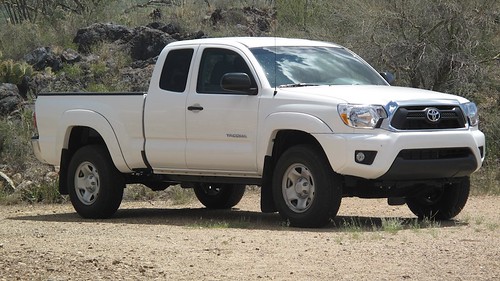 The Tacoma as we got it, with stock P245/75R16 all-season tires (30.5" diameter). It’s true that a mild suspension lift will increase chassis ground clearance and—if properly specced for the vehicle—improve suspension travel and compliance, enhancing both ride comfort and the ability of the truck to keep all four wheels on the ground for better traction when traversing rough terrain. Larger-diameter tires also increase ground clearance, and provide a fractionally longer footprint that can enhance traction.
The Tacoma as we got it, with stock P245/75R16 all-season tires (30.5" diameter). It’s true that a mild suspension lift will increase chassis ground clearance and—if properly specced for the vehicle—improve suspension travel and compliance, enhancing both ride comfort and the ability of the truck to keep all four wheels on the ground for better traction when traversing rough terrain. Larger-diameter tires also increase ground clearance, and provide a fractionally longer footprint that can enhance traction.
But there is a price to be paid for those gains. Let’s look at tires first.
A larger tire weighs more than a smaller tire—common sense, obviously, but the range of effects of that weight are not all obvious. As an example, let’s compare a couple of BFG All-Terrains. The LT235/85 R16 ATs we recently installed on the Tacoma are 31.7 inches in diameter, and weigh 46.4 pounds each. If we decided to go up in diameter a very modest 1.5 inches, to a 295/75 R16 AT at 33.2 inches diameter, that tire weighs 57 pounds. That’s ten pounds of unsprung weight (a term that refers to weight not supported by the suspension, including wheels and tires, brake components, bearings, axles, etc.—think of everything that goes up and down under the vehicle when you hit a bump) to gain 3/4-inch of ground clearance. Adding ten pounds to a vehicle’s unsprung weight has a far more dramatic effect on ride and handling than adding the same amount to the sprung mass. The springs and shock absorbers have to react to that weight over every imperfection in the road.
But that’s not the only effect. The mass of a larger tire (and, if fitted, a wider wheel) places additional stress on the braking system and retards acceleration—and the tire’s rotational moment of inertia, which increases with the square of diameter if I’m remembering my physics correctly, affects both as well. A 2003 study of the effects of suspension lifts and larger tires showed that going from a 32-inch tire to a 35-inch tire resulted in a ten percent loss in brake efficiency. That’s a significant effect on your ability to stop quickly.
Finally, a larger-diameter tire affects gearing. For example, at a constant 65 mph, the engine in a vehicle equipped with 4.11 differentials, a 1:1 top gear in the transmission, and 31-inch tires will be turning approximately 2900 rpm. With 33-inch tires the same vehicle will be turning 2720 rpm. That might sound like a good thing—after all, lower engine speeds should equate to better fuel economy, right? Unfortunately, it’s rarely so. You’re messing with a torque curve that the factory knows inside and out, and you can bet they’ve calculated the final drive ratio to optimize that curve. The losses associated with the extra mass and rotational inertia will almost certainly cancel out any possible gains in highway mileage with increased city consumption, as shown by numerous controlled studies.
Going up in tire diameter will also hurt your low-range performance, since the vehicle will be traveling faster at any given engine speed. That will reduce your control in low-speed situations. Few vehicles these days come with low-range transfer-case gears I consider low enough anyway (although the now nearly ubiquitous automatic transmission helps), so compromising what’s there makes little sense.
Why not simply regear the differentials to compensate, as dedicated rock crawlers do when they install those big 40-inch-plus tires? In terms of correcting the overall final drive ratio, it works—but at the expense of differential strength. The problem lies in the pinion gear, the only gear of the two major pieces in the differential one can change in size to alter the gearing (the ring gear is limited by the size of the differential case itself). So when one goes from, say, a 4:1 differential to, say, a 5:1, the pinion gear is essentially reduced in size from one fourth the size of the ring gear to one fifth its size. Additionally, the smaller pinion gear means that fewer teeth will be in contact between the two gears at any one time. And you still face the inescapable physics of accelerating and decelerating a larger, heavier tire. Breaking a diff on a local rock-crawling trail would be a pain. Breaking a diff on the Dempster Highway—or on the Dhakla Escarpment—would be a major pain.
What about suspension lifts? Done correctly (i.e., with properly rated springs and shocks; no eight-inch shackles or lift blocks), and kept within reasonable limits (two to four inches on most vehicles, especially those with independent front suspension), the biggest disadvantage you’re likely to encounter is increased drag and reduced fuel economy. True, your center of gravity will be fractionally higher, but the increased ground clearance for approach, breakover, and departure angles is probably a fair tradeoff. However, on a truck with a cabover camper, overhead clearance becomes an issue. On some of the biological surveys we do in Mexico, trees hang low enough over the approach trails to be a concern even with a stock suspension.
All this might sound like I’m dead set against straying at all from factory suspension heights and tire sizes. Not at all—but doing so does involve compromise, and the further one strays from stock tire sizes and suspension heights, the more compromises involved. As long as you’re aware of the issues, consider the cost/benefit ratio, and don’t go all monster truck, your approach might well be different than ours yet still effective for you. Consider my FJ40, which has both a mild (two-inch) Old Man Emu suspension lift and tires (255/85R16 BFG Mud-Terrains) that are at 33 inches significantly larger than the teeny factory-supplied 29-inch tall Dunlops. I settled on the combination after years of driving the vehicle stock, and with careful consideration of the drivetrain. The FJ40’s rear axle shafts are the same diameter as those in a Dana 60 (which is installed on 3/4-ton pickups), and its ring and pinion gear are nearly as stout—I’m on my original differentials at 320,000 miles. The front Birfield joints are not as bulletproof, but very few FJ40 owners have problems with them unless they’re running 35-inch or taller tires with power steering (my steering is powered by how hard I can turn the wheel). Mechanic-friend Bill once said that if I ever broke a Birfield with my setup he’d drive out and replace it for free. He hasn’t yet had to pay up on that offer. Also, significantly, the 1973 FJ40 came from the factory with drum brakes on all four wheels. I’ve installed discs all around, so my braking system is far superior to the factory setup even with the larger tires.
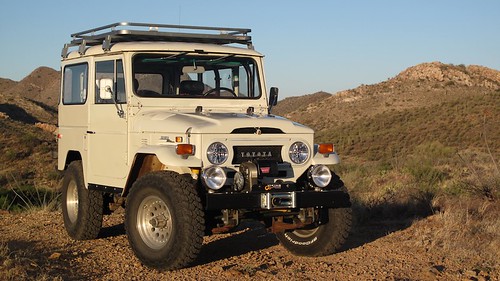 With a two-inch OME suspension, 255/85/16 tires are a good fit on the FJ40. Rear tires tuck into fender well without rubbing when springs are fully compressed.
With a two-inch OME suspension, 255/85/16 tires are a good fit on the FJ40. Rear tires tuck into fender well without rubbing when springs are fully compressed.
Given our intended use of the JATAC, which will combine long trips on pavement, extended mileage on dirt roads (we drive seven miles of dirt road just to get home), frequent use on four-wheel-drive trails, but little or no intensive rock crawling/mud surfing unless we find ourselves in a situation that requires it, we elected to stay with a very moderate size increase on the tires (to those 235/85/16 BFG All-Terrains), and stock suspension height. I leveled the back end of the truck with a set of excellent Boss air bags over the stock springs, and the shocks at all four corners are adjustable Icons with remote reservoirs.
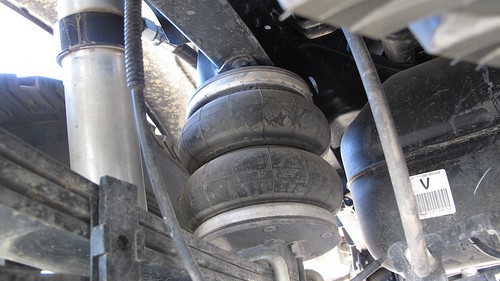 Boss air bags augment the Tacoma's stock springs to maintain a level stance with varying loads.
Boss air bags augment the Tacoma's stock springs to maintain a level stance with varying loads.
We still plan to augment the JATAC’s off-pavement capabilities in other ways. First, we’ll be adding a locker for the rear differential—after tires (maybe even before) the absolute best way to enhance traction in difficult situations. Second, we’re working with Pronghorn Overland Gear on a prototype aluminum winch bumper. Pronghorn has just introduced an extremely high-quality modular bumper system for the Jeep Wrangler; the Tacoma is next on their list, and if the result is as good as the Wrangler version it will be good indeed—improbably light yet strong enough to take the the most demanding stresses of winching without complaint*. The Pronghorn bumper will also be compatible with the Hi-Lift jack already mounted to the Four Wheel Camper (see here). With a winch mounted up front we’ll have a backup plan if our tires and locker (and piloting) can’t get us out of a sticky situation. Finally, Pronghorn will also be developing a full aluminum skid-plate system for the Tacoma, so if our moderate ground clearance proves inadequate now and then, the underside of the truck will be fully protected.
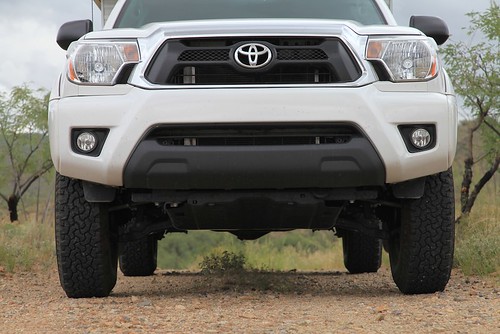 As with many trucks employing independent front suspension, the lowest spot on the JATAC's undercarriage is the rear differential, visible here beneath the front factory "skid plate." The diff's placement in the center of the axle means it's more likely to drag on high-crowned trails. Larger-diameter tires would increase this clearance fractionally; a suspension lift would not.
As with many trucks employing independent front suspension, the lowest spot on the JATAC's undercarriage is the rear differential, visible here beneath the front factory "skid plate." The diff's placement in the center of the axle means it's more likely to drag on high-crowned trails. Larger-diameter tires would increase this clearance fractionally; a suspension lift would not.
This reminds me: I keep meaning to add a set of MaxTrax as well. We were recently on the Grand Canyon’s North Rim after a heavy rain, and the washes in the House Rock Valley had flowed energetically. The first one we came to had subsided to a trickle, but the substrate was still treacherous. The odds were nearly certain we could have crossed with no trouble, but we were a single vehicle with no winch. A stuck truck could have meant hours of digging out, with more rain and flash floods likely. Additionally, beyond this first wash were several larger ones between us and our goal on the rim. So we turned around. A simple set of MaxTrax (or any of several other suitable brands of sand track) would have given us the confidence to take the slight risk.
The JATAC on its modest tires and stock-height suspension might not have the brawny look of a taller sister truck on meatier tires, but we’re convinced it was the right approach for us and our intended uses. But I’ll be honest—if we change our minds, I’ll let you know.
Boss Global is here. Icon Vehicle Dynamics is here. Pronghorn Overland Gear is here. Maxtrax is here.
*Full disclosure: I consulted with Pronghorn on some final design details and proof of concept of their Wrangler bumper system.
Oil change: A simple job . . .

. . . unless you don't get the (separate) O-ring gasket lined up properly on the canister filter cartridge on your 300D. The O-ring is at the top of the filter housing, so I didn't realize it wasn't in correctly until I fired up the engine. It had in fact slipped completely down around the filter, leaving no seal whatsoever.
So this was the sight that greeted me through the windshield as I backed up the slope thinking I was finished. My own little Exxon Valdez. Pulled it back down, re-installed the O-ring properly. Now for some Simple Green and absorbent compound.
Just goes to show that a brilliantly conceived one-case tool kit does no good if you don't use the tools contained therein properly.
JATAC gets an outdoor kitchen
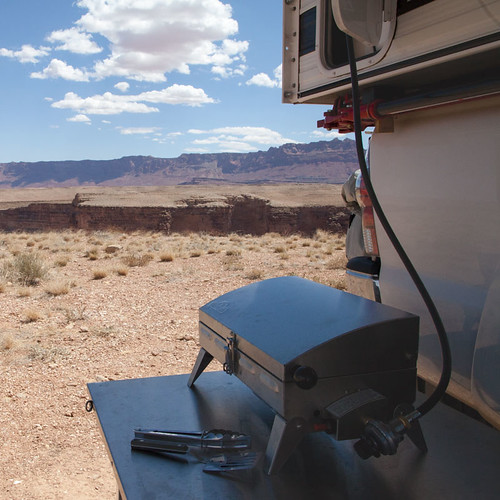
by Roseann Hanson (co-director, Overland Expo)
There's a lot I love about having a stove, sink, and fridge inside a truck camper—all-weather cooking, protection from mosquitoes, and the convenience of a full kitchen (see this article, about our "Just a Tacoma and Camper" setup). But I miss cooking outside. It's more social, and enjoying the views is why we explore and camp. Nothing like sipping a cool drink, tending some thick pork chops, and gazing out over the Grand Canyon while a condor soars overhead . . .
To facilitate outdoor cooking, we sorted out a camp table and awning. Jonathan rigged us a sleek and easy mount for the sturdy stainless steel table from Frontrunner Outfitters (see story here). And although it was initially a tough decision ($800), we invested in a high-quality, quick-deploying Fiamma awning for the starboard side. Importantly, this is also the side for access to the Four Wheel Camper's dual 10-pound propane tanks, since I settled on a propane grill, for convenience and when local fire restrictions or wood availability obviates our Snow Peak portable fireplace grill. My idea was to leave one tank hooked up to the inside stove and hot water heater, and the second tank rigged with a portable grill hose so all we had to do was hook it up and start cooking.
Now all I needed was a portable propane grill that was powerful, not too bulky, high-quality, and functional.
Easier said than done. I looked at many name brands, including Coleman, Char-Broil, Weber, and NexGrill (a sister brand of Jenn-Air). Some had great BTU ratings (the NexGrill boasts 20,000 and has 2 burners with separate controls). Some were clever (the Coleman Road Trip has an integrated stand that scissors down, so you don't need to use up valuable table space). Some were cheap (the Char-Broil at $30 via Amazon—with the savings you could buy a lot of top sirloin . . .). Some were compact (the Fuego Element closes like a sleek clamshell and is just 9x12).
But in the end my eye was caught by the Napoleon PTSS165P portable grill ($189 MSRP), built for the demanding marine environment (you can order very pricey sailboat cockpit mounts for it). Runner up was the NexGrill (model 820-0015, $180 at Home Depot) but reviews on Amazon indicated the finish quality was poor, with some users claiming not all parts are stainless, or were flimsy with sharp edges. The quality of the Napoleon looked so good, I decided to take a gamble on its 9,000 BTUs (compared to twice that for the NexGrill) and single burner control.
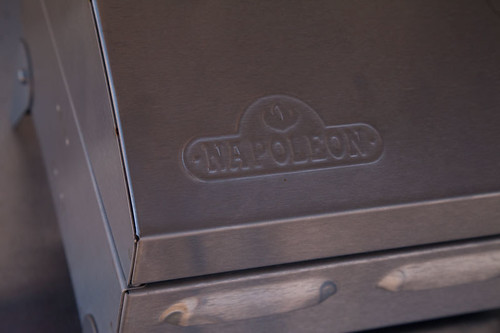
The finish quality of the Napoleon is beyond reproach: folded and riveted corners, smoothly finished vent holes, and sturdy (not at all "tinny") 304 stainless throughout.
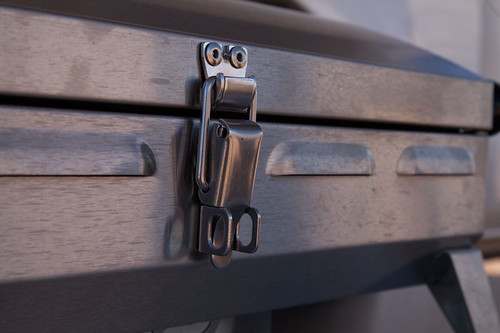
Details like the high-quality latch and rivets won me over.
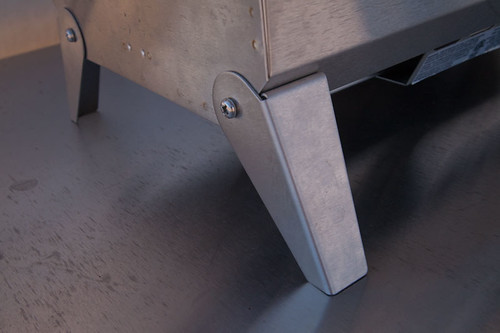
The four-inch legs are anchored with stainless bolts, and pivot flush to the bottom for storage. Only complaint: they do scratch the tabletop, so we're going to coat the bases in Plasti-Dip.

The handle stays cool even after long periods of cooking. However, it's on the wrong side for a right-handed person (when grilling, you usually hold a utensil in your right hand and would use your left to open the grill to check cooking progress). The pietzo-igniter stopped working after the first night. The propane regulator is also on this side. The Napoleon only comes with a mount for small 1-pound canisters; we had to buy a 5-foot hose to connect it to our 10-pound tank.
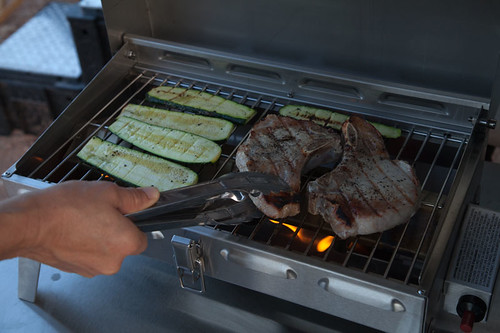
Cooking area is 17.25 x 9.25 and just about perfect for two people. For more food than that, cooking in shifts would be recommended. To get searing temperatures, the instructions recommend lighting the grill and pre-heating for 10 minutes. This did produce temperatueres just right for searing the pork chops. I do wish it had two burners so I could turn one off to create a cooler location for finishing things like vegetables.
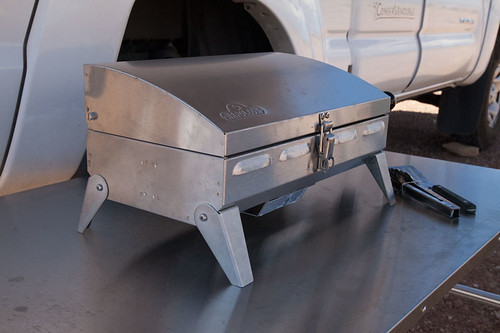
The slightly domed lid is vented but very windproof (we cooked two dinners in 10-15 MPH gusts), and its height would allow cooking a small whole chicken or something in a deep-dish pan; you could even bake a cake or low-top bread. There is a slide-out grease trap tray on the bottom, which made clean-up super easy.
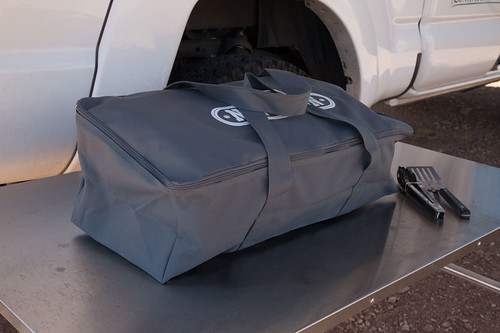
The carrying case fits well but its quality is not commensurate to the grill: the fabric is thin Cordura and is poorly sewn (on ours, the inside pocket for the gas regulator pulled out at the bottom), so I'm not expecting it to last as long as the high-quality grill.
We've now used the Napoleon half a dozen times on a 2,800 mile trip, and are overall extremely pleased with the quality. It's also transformed our camping by doubling our "living area" to include a spacious, convenient, shaded outdoor kitchen where we can easily grill salmon steaks, cook lasagna, bake a cake, or turn out bacon and pancakes on a griddle for a small group.
(Awning: Fiamma.com; table: FrontrunnerOutfitters.com or a similar version from K9 racks and Equipt Expedition Outfitters, available in three sizes)
Outdoor Retailer 2013
 This was tucked in a far back corner of the main hall. I didn't ask.
This was tucked in a far back corner of the main hall. I didn't ask.
For anyone remotely interested in outdoor gear, the annual Outdoor Retailer show in Salt Lake City, Utah, is an exciting event, overwhelming in the scope and sheer volume of products. If you’re as fascinated by equipment as I am, you’re likely to find yourself humming the tune to Babes in Toyland as you enter the main hall and inhale the scents of Gore-Tex, carbon fiber, nylon, and titanium. Okay, none of those materials really has a scent, but you get my meaning.
I’ve been attending OR since the early 1990s, when it was still held in Reno, Nevada. (Persistent legend holds that the show was simply not invited back there one year when Reno officials belatedly realized that the attendees weren’t gambling or buying tickets to Englebert Humperdinck concerts.) Over the years, the show has had its minor ups and downs, but the 2009 and 2010 SLC post-Great-Recession ORs were scary in their dearth of both exhibitors and new products. Like the automotive industry after WWII, most companies simply recycled products with new colors rather than invest in development, while they waited to see in which direction the economy would go.
In 2012 the tide seemed to have turned. The Salt Palace Convention Center was packed with both exhibitors and attendees, the mood was buoyant, and I fully expected the 2013 show to be full speed ahead.
What I found was, to sum up a complex situation in one word . . . ennui. What can I say about a show in which one of the most interesting products I noticed was a tent stake?
The main hall of the center is where all the big guns in the outdoor equipment world hold court: Patagonia, Cascade Designs, Arc-teryx, The North Face, Marmot, etc. While there were a few highlights here (to be highlighted in a bit), the overall impression was of an industry either dangerously complacent or suffering from renewed pessimism. A worse prognosis came from a cynical friend in the community who dismissed the entire event with, “It used to be about people getting out and doing cool things. Now it’s about the lifestyle—people looking like they get out and do cool things.”
That might be too harsh, but not much I saw belied the viewpoint. For years the centerpiece of the south hall area was some form of climbing wall, open to anyone who cared to give it a try and always busy. Gone. Move north along the main aisle and you’d hit the big indoor pool where kayak manufacturers demonstrated their new models. Gone. Versions of both have been banished to the “Pavilions”—county-fair-sized tents north of the convention center, where new and/or underfunded companies hope to strike gold. The only “outdoor sport” in evidence in the main building was a slackline manufacturer’s demonstration area. Indoors and 12 inches off the floor, a slackline (basically a tightrope employing a strap rather than a rope) strikes me as something pinched from a county fair booth where you might win a stuffed animal if you can stay on it for ten feet (those who practice it over 2,000-foot chasms are, of course, in a different league). Yet, indeed, there seemed to be no shortage of clothing manufacturers—even Carhartt, traditionally a blue-collar supplier to construction workers and cowboys, was getting in on the craze, and touting their seniority to effete upstarts such as Mountain Khakis. Is this clothing/lifestyle thing really a trend, or did I employ motivated reasoning to reinforce unfair first impressions? Perhaps next year will tell.
Anyway, enough expostulating. Three days at OR were enough to ferret out a few products of note. Some were brand new and intriguing, some I had dismissed previously as unlikely to survive, but re-evaluated on their second or third appearance.
 A traveling coffee pot one inch high . . .
A traveling coffee pot one inch high . . .
Coffee being uppermost in my mind each morning, I should start with the brew-in-bag product from Nature’s Coffee Kettle. It comprises a two-compartment foil pouch, in the top of which is a hermetically sealed packet of ground coffee of various flavors. You zip off the top, slowly pour in 32 ounces of boiling water, and the brewed coffee collects in the bottom section, from where it can be poured out through a screw cap. The sealed packet can be folded to take up a space no larger than six by eight inches by an inch thick. Although the product has been around a while, I never paid attention since the bag appeared to be a one-time-use-then-it’s-trash product. However, this time I stopped and spoke to the inventor, Matt Hustedt, who assured me the packet of grounds can be replaced, so the foil “kettle” could be used a half-dozen times or more.
I brought a couple samples home and tried the organic Columbian. After opening the top and eyeing the packet of coffee, I cut the amount of water I poured in to 24 ounces, and in addition, as Matt had suggested to enhance the boldness, upended the kettle several times to recycle the water through the grounds (be sure to rezip the top if you do this!). The verdict from this fan of strong, high-quality coffee, was . . . bravo. The flavor and strength were surprisingly good, although I’m glad I cut the water. I suspect the brew would have been even better if I’d poured in the water more slowly at the start.
While some (especially motorcyclists) might use the Nature’s Coffee Kettle as a primary travel brewing device; given its sealed nature (Matt claims to have brewed good coffee with two-year-old pouches) and nearly flat dimensions, I’m thinking one or two of them would be good backups to keep stashed somewhere in case you ran out of your Tanzanian Peaberry beans in the backcountry, or your hand-cranked burr grinder explodes and you can’t find a metate.
While on the subject of beverages, let’s move later in the day and talk about freeze-dried beer.
 Backcountry soda and . . . beer?
Backcountry soda and . . . beer?
No, I’m not kidding, although “freeze-dried” is a deliberate misnomer. Like many of us, Patrick Tatera often wished for a way to enjoy good beer far in the backcountry, without the exertion of carrying it there. Rather than try to brew beer and then dehydrate it, he invented a method of brewing the “beer” parts of beer—i.e. the malt, hops, alcohol, etc.—into a concentrate. He then invented a bottle called a carbonator, which infuses that concentrate into the ice-cold mountain spring water you’ve collected 15 miles into your backpacking trip, and carbonates the lot. The result? Well, I’m not sure what the result is, as I haven’t yet tasted the finished product. But Patrick claims to be a devotee of high-quality beer, and none of the available brews claims to replicate PBR, so I plan to follow up and report. Pat’s Backcountry Beverages, as the company is known, also produces concentrates for soft drinks. I’ll try those too.
About that tent stake: It’s from UCO, a division of Industrial Revolution. It looks like an ordinary V-shaped aluminum tent stake, except for the cunning little LED light that slips over the top once you’ve pounded in the stake. Powered by a single AAA cell, it can be set to a 17-lumen constant glow, or a strobe. Besides obviating those headlong trips over tent stakes we’ve all accomplished, it will locate your tent for after-hours hikes. Neither the 10-hour burn time on constant nor the 24-hour life on strobe strike me as particularly efficient; I think they could halve the lumens and still effectively light the stake.
 No more nighttime faceplants over tent stakes
No more nighttime faceplants over tent stakes
At the Industrial Revolution booth I also picked up some of their stormproof matches. These aren’t your ordinary stormproof matches: Strike one, and when its orange secondary material is burning fiercely, dunk it in a glass of water. Pull it out, give it a shake—and it will keep right on burning. Impressive. To go with them in my survival kit I added some Flame Sticks from Ace Camp. These green plastic sticks look like flashing from some molded product; you’d toss them in the trash if you didn’t know better. But once lit they’re reported to burn powerfully for five minutes, which is exactly what I got out of one in a light breeze. The sticks are too long to fit in the waterproof case the matches came in, so I clipped the ends off a half-dozen. There should be few circumstances in which I couldn’t get a fire going with this combination, except at the bottom of a pond.
 If you can't light a fire with these, turn in your merit badge.
If you can't light a fire with these, turn in your merit badge.
Over the years I’ve tried several brands of cargo nets to secure those awkward loads in the cargo bay of Land Cruiser wagons, Wranglers, and Defenders, or on roof racks. I’ve hated all of them. It’s nothing to do with the products, really, it’s just that to wrap a variety of objects in a variety of vehicles, they wind up being huge, tangle-prone, and awkward, and more often than not snug nicely around half the contents while leaving the rest bouncing. But frequently ratchet straps just can’t encompass everything that should be secured. So I’m cautiously excited by the Lynxhooks interlocking tiedown system, a completely modular and infinitely expandable product comprising individual straps with adjustable buckles, a short length of natural rubber bungee, and a pair of hooks. The hooks are the clever part, as they can either connect to a tiedown point or snap to another hook—or five or ten other hooks—to create a custom-sized and custom-shaped spider of straps (or, of course, each strap can be used as . . . a strap). I got a sample, but plan to ask for more to create a net for the back of my FJ40. I’ll report in full then, but I don’t see how they wouldn’t work as advertised.
 The Lynxhooks snap together to form custom cargo nets.
The Lynxhooks snap together to form custom cargo nets.
Finally, on to more advanced equipment. I walked past a booth in one of the pavilion tents and spotted a bunch of little square bricks perched here and there, each proclaiming “Text Anywhere.” I thought they were just cute displays, but it turns out they’re the actual device: Connected by wi-fi to any smart phone, they utilize the worldwide Iridium satellite system to allow two-way text messaging from pretty much anywhere on the planet. The device is $399, a subscription including 100 texts is $30 per month, you can idle the account for $5 per month, and it’s compatible with Apple, Microsoft, Android, Linux, or Blackberry operating systems. I wheedled the sales manager, Garry Harder, into sending one home with me then and there. I’ll review it soon, then we plan to take it to Kenya this fall where we’ll be working on another project with the Maasai and will be in the proper area for a real test. If it works as promised, it will be a huge step up from the typical one-way SPOT-type device.
 TextAnywhere plus a smartphone = global texting.
TextAnywhere plus a smartphone = global texting.
More as I sift through 20 pounds of dealer catalogs, scribbled notes, and iPhone photos.
See our Flickr set Outdoor Retailer 2013 for more images of interesting products not covered here.
Nature's Coffee Kettle is here.
Pat's Backcountry Beverages is here.
Industrial Revolution is here.
Lynxhooks is here.
TextAnywhere is here.
Hint: When using “Search,” if nothing comes up, reload the page, this usually works. Also, our “Comment” button is on strike thanks to Squarespace, which is proving to be difficult to use! Please email me with comments!
Overland Tech & Travel brings you in-depth overland equipment tests, reviews, news, travel tips, & stories from the best overlanding experts on the planet. Follow or subscribe (below) to keep up to date.
Have a question for Jonathan? Send him an email [click here].
SUBSCRIBE
CLICK HERE to subscribe to Jonathan’s email list; we send once or twice a month, usually Sunday morning for your weekend reading pleasure.
Overland Tech and Travel is curated by Jonathan Hanson, co-founder and former co-owner of the Overland Expo. Jonathan segued from a misspent youth almost directly into a misspent adulthood, cleverly sidestepping any chance of a normal career track or a secure retirement by becoming a freelance writer, working for Outside, National Geographic Adventure, and nearly two dozen other publications. He co-founded Overland Journal in 2007 and was its executive editor until 2011, when he left and sold his shares in the company. His travels encompass explorations on land and sea on six continents, by foot, bicycle, sea kayak, motorcycle, and four-wheel-drive vehicle. He has published a dozen books, several with his wife, Roseann Hanson, gaining several obscure non-cash awards along the way, and is the co-author of the fourth edition of Tom Sheppard's overlanding bible, the Vehicle-dependent Expedition Guide.



